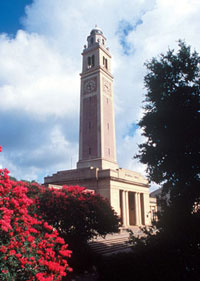 The site of the University is historic ground; over it hovers the romance of the struggles of the Great Powers for supremacy in the Mississippi Valley. These extensive grounds and splendid buildings, the princely gift of our national government, were occupied successively by the armed battalions of France, England, Spain, and America.
The site of the University is historic ground; over it hovers the romance of the struggles of the Great Powers for supremacy in the Mississippi Valley. These extensive grounds and splendid buildings, the princely gift of our national government, were occupied successively by the armed battalions of France, England, Spain, and America.
Here, in 1779, Galvez, the Spanish Governor General of Louisiana, after three days’ battle, captured the British garrison under Col. Dickinson.
Here, in 1810, Philemon Thomas, with his mixed band of pinewoodsmen and Ohio flatboatmen, captured the Spanish post, killing Grandpre, its commander, and wrestling West Florida from Spain.
Here nearly every prominent officer in the United States army since the Revolution did duty. Wilkinson and the first Wade Hampton, Revolutionary heroes, commanded here, as did afterwards Gaines and Jesup and Taylor, heroes of the War of 1812.
Here Winfield Scott, the conqueror of Mexico, saw his first service as lieutenant of artillery. Here Lafayette was received by the military and citizens in 1824, and Andrew Jackson later.
Here was the home of Zachary Taylor, hero of Buena Vista and President of the United States, and of his brilliant son, “Dick,” the distinguished Confederate general.
Here, in 1861, the Louisiana State Guard, before the secession of Louisiana, took the garrison and the arsenal, with all their munitions of war, from the United States troops.
Here, in 1862, General Breckenridge: commanding the Confederates, fought a desperate battle with the Union army and navy under Williams and Farragut. Williams was killed, and the Confederate ram Arkansas was blown up in full view.
These grounds were trod by Grant and Lee, Sherman and “Stonewall” Jackson; by McClellan and the Johnstons, Bragg and Rosecrans; by Forrest and Phil Sheridan, Hardee and Hood; by Hancock and Custer, Admiral Porter and Bishop-General Polk; and by the great civilians, Clay and Calhoun, Abraham Lincoln and Jefferson Davis.
“Loose thy shoe from off thy foot, for the place whereon thou is holy”
This note was carried in the University catalog for nearly a quarter of a century when LSU was located at the Pentagon Barracks site.
